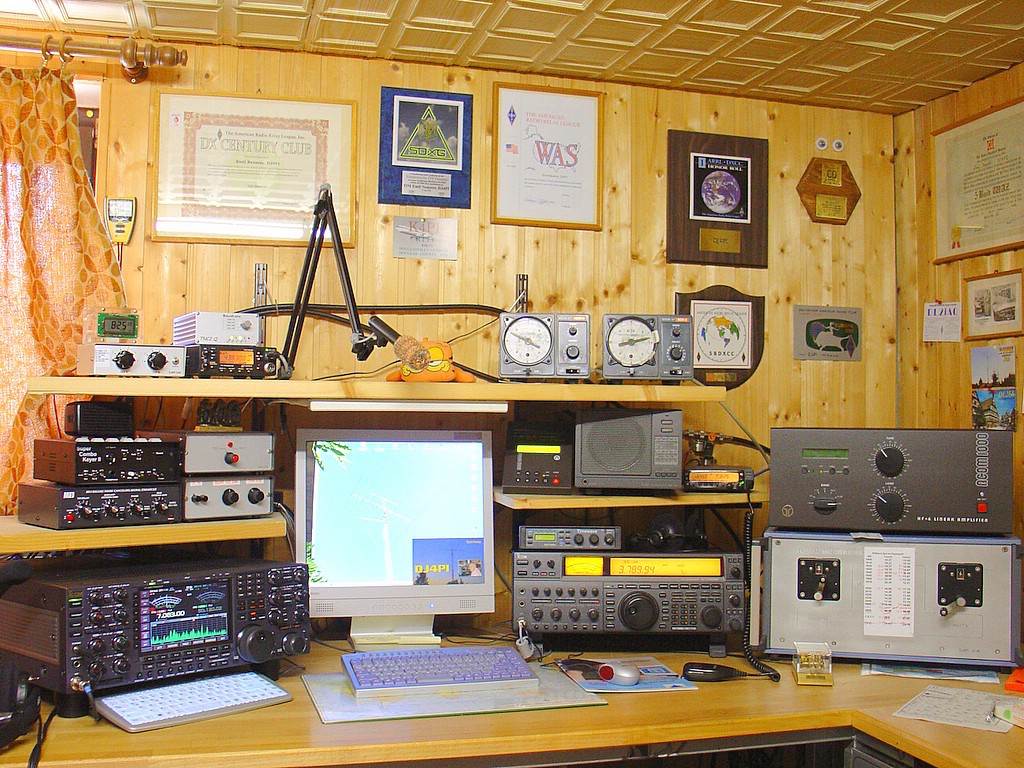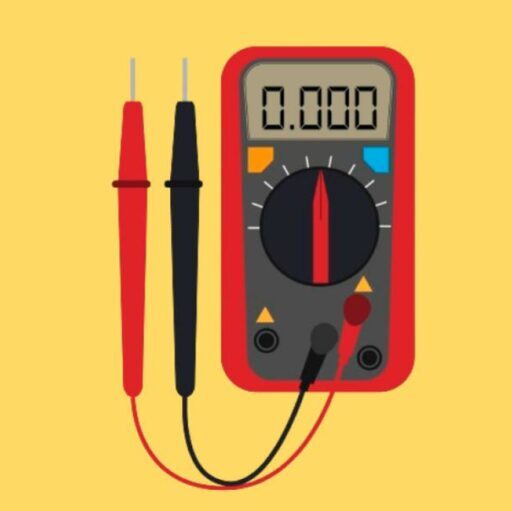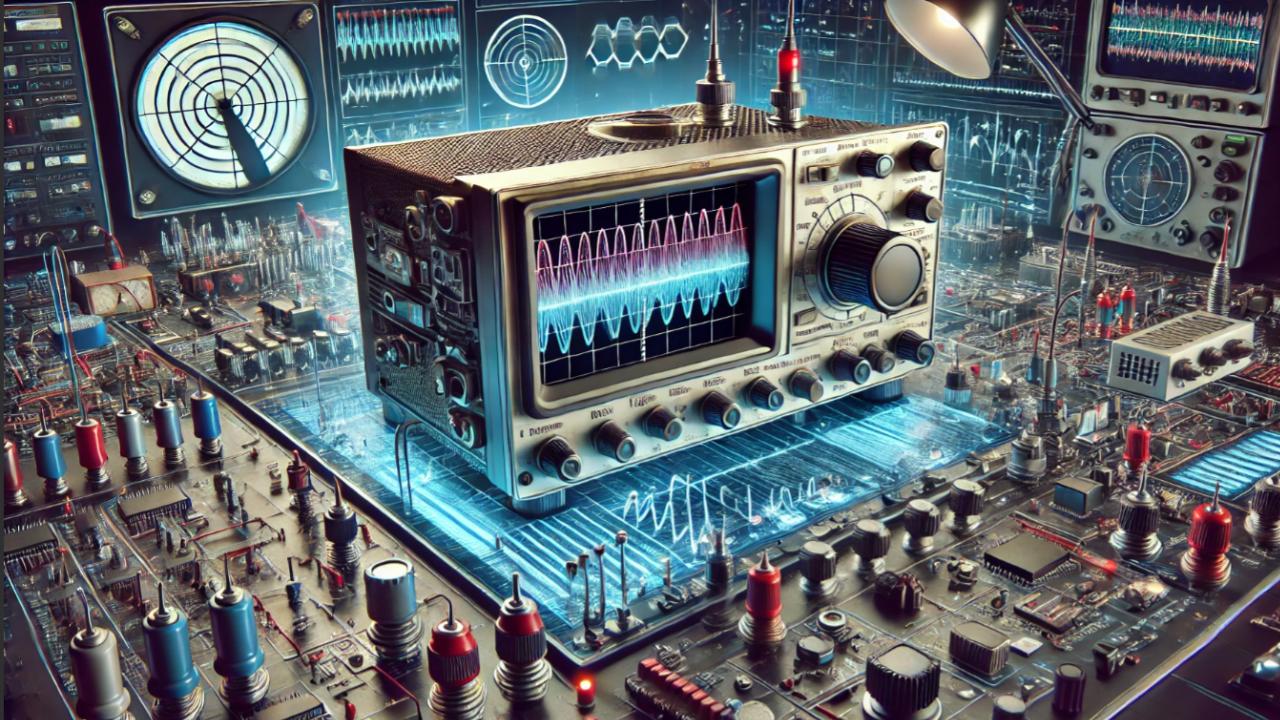Modern oscilloscopes are necessary for Amateur radio operators who want to step up to the advanced level of troubleshooting and assessing the performance of ham radios.
Various types such as analog, digital and hybrid scopes are available in the market today with different prices, quality, and features. We have done the research and found that Rigol DS1054Z is top pick on the list with Siglent SDS1202X-E coming in at second place. Without further ado let’s get into the details.
Table of Contents
Quick Summary of our Top Picks
Before we get into the detailed reviews, let’s get a quick snapshot of the oscilloscopes that made it to the top of our list.
- Editor’s choice – Rigol DS1054Z “the unit is rock solid and goes beyond my expectations for build quality”
- Runner Up – Siglent SDS1202X-E “This is a huge bang for the buck. I’ve had it for less than 24 hours but am absolutely delighted with how well it works. Even though this is my first oscilloscope, I quickly figured out how to use it for measuring RF waveforms relevant to ham radio.”
- Budget Pick – Hantek DSO5102P Oscilloscope “Using the product for testing arduino PWM projects, radio repair, and general electronics learning. Works great!”
- Notable mention – Siglent SDS1052DL Digital Oscilloscope “I bought this as a general purpose scope for testing RF transmitters and modulation envelopes. I came away very pleased with its many features for an incredibly low price.”
Competitive Analysis
Here’s a quick look at how the key specifications of the top oscilloscope picks compare with one another
| Product | Sampling Rate | Bandwidth | Channels | Memory |
| Rigol DS1054Z | 1 GSa/s | 100 MHz | 4 | 24 Mpts |
| Siglent SDS1202X-E | 1 GSa/s | 200 MHz | 2 | 14 Mpts |
| Hantek DSO5102P | 1 GSa/s | 100 MHz | 2 | 40 kpts |
| Siglent SDS1052DL | 0.5 GSa/s | 50 MHz | 2 | 32 kpts |
Editor’s Choice – Rigol DS1054Z
We have selected Rigol DS1054Z as the top pick in the list of best oscilloscopes for Ham radio due to its prominent features such as the availability of four channels to compare multiple signals at a time.
This digital scope features a high sample rate of 1 GSa/s for providing fine temporal resolution and signal details. These key specifications help troubleshoot radio systems. This scope also supports various trigger functions to pinpoint issues in RF hardware. The Rigol DS1054Z comes with an impressive memory capacity of 24 Million Points (Mpts) which allows raw data sample storage for signal analysis. This longer than average record length enables an operator to visualize the full modulation envelope of a radio signal.
A ham radio operator can conduct numerous measurements using this scope to expand his knowledge about radios. Everything from RF power measurements for determining a signal’s frequency response to measuring transmitter overshoot to two-tone signal testing (IP3) of a transceiver through FFT function.
You can easily visualize the envelope of modulated signals with its intensity graded display and large memory capacity. An operator can easily look at modulated signals by its intensity graded display. The device features 50 MHz bandwidth which can be expanded to high enough bandwidth of 100 MHz for showing HF band transmissions. You can buy a license for 100 MHz but can also enable this feature for free by upgrading the software features using generated software key. Here is a video that shows you how to expand the bandwidth of the Rigol DS1054Z.
A large 7” TFT screen clearly displays four channels simultaneously. This visualization capability is one of the top features of this scope. The Rigol DS1054Z is best for hams as it has up to 30,000 waveforms/s (wfm/s) waveform capture rate to provide deep insight into signal behavior and 16 digital channel logic analyzer to debug complex systems interactions. It has a variety of math functions with real-time waveform records and exceptional overall build quality. The availability of multiple advanced features like serial triggering options for speed analysis, debug of I2C, SPI, RS-232 designs, and many others to easily monitor your transmissions makes it the top pick in this list.
PROS
- 4 channels to visualize multiple sources at the same time
- Record length of 24 Mpts for long time capture to visualize complete modulation envelope of signal and quickly identify problems in complex signals
- Built-in logic analyzer
- FFT function for frequency domain signal analysis
- Intensity graded display available to observe events that occur frequently over time.
- Large 7” screen to visualize multiple signals simultaneously
- High sample rate of 1 GSa/s
Cons
- Fan noise can be loud and disturbing
- No independent vertical settings control for channels
User Reviews
With a rating of 4.8 out of 5, the majority of customers are satisfied with the performance of the Rigol DS1054Z. This is a high-quality instrument with many attractive features like the availability of 4 channels, large multi-graded intensity display, multiple trigger modes, high sample rate, and impressively large memory depth which makes it extremely useful for ham radio enthusiasts. You can easily visualize multiple sources through it. The auto function is satisfactory for customers for debugging standard signals. This digital oscilloscope is the best option for hams to check the visual quality of the transmitting signal.
Runner Up – Siglent SDS1202X-E
The Siglent SDS1202X-E is one of the best oscilloscope options available in the market for ham radio operators due to its professional-grade features such as 200 MHz bandwidth, availability of 2 channels, and sampling rate up to 1 GSa/sec. The record length of 14 Mpts and number of channels is less than Rigol DS1054Z scope.
However this Siglent scope has a bandwidth of 200 MHz to troubleshoot more complex RF devices. The wide bandwidth helps in a direct display of high-frequency transmissions of radio’s SSB transmitters. The two-tone method can also be applied for checking the linearity of the transceiver via FFT function in this scope.
The absence of logic analysis and the presence of only 2 channels is one of the Siglent SDS1202X-E‘s major drawbacks which makes it less appealing for professionals with advanced needs. This high-performance oscilloscope also supports standard serial bus triggering, IIC, SPI, UART, RS-232, CAN and LIN with 7 inches TFT LCD.
The Siglent SDS1202X-E scope comes with roll mode which can be useful for hams to view a detailed picture of an envelope. A ham radio operator can look at the signal’s complete modulation envelope with its deep memory storage capability. You can perform all basic testing of ham radios with this scope. The deep memory of 14 Mpts and 1 GSa/sec sampling rate provides the ability to capture fast transients for longer time intervals. This makes the a very worthy runner up in this list.
Pros
- High bandwidth of 200 MHz to troubleshoot complex devices
- High sampling rate of 1 GSa/sec
- Large memory depth of 14 Mpts
Cons
- Availability of only 2 channels for visualizing signals
- No HDMI port available for display on a larger screen
User Reviews:
The most appealing feature of this Siglent scope for the ham radio operators is its high-frequency support of 200 MHz to troubleshoot more complex devices. The majority of customers are satisfied with the overall performance of the device and for the feature set, the price tag is considered reasonable. This is a high-quality oscilloscope with guaranteed high performance.
Budget Pick – Hantek DSO5102P Oscilloscope
This digital storage oscilloscope comes with 100 MHz bandwidth and two channels. It has a high sampling rate of 1 GSa/s which makes it suitable for hams to troubleshoot radio devices. The 100 MHz bandwidth is high enough to display high-frequency broadcasts.
This Hantek oscilloscope has a large full-color 7-inches LCD and memory depth of 40 kpts for storing a wider portion or time frame of the signal. Hams can easily test RF transmitters and modulation envelopes through this scope. It also features a USB host and device connectivity. Multiple automatic measurements can be performed through this affordable oscilloscope. This oscilloscope can take incredibly precise measurements which is quite impressive considering its price tag. This is a good affordable oscilloscope for operators with a great user interface and intuitive-to-use menus.
PROS
- Menus are intuitive to use.
- Easy to setup
- High sampling rate and full color 7” display
- Affordable
CONS
- Fragile adjustment buttons.
- Limited functionality
- Slow PC software
USER REVIEWS
With a rating of 4.6 out of 5 stars, the majority of customers are satisfied with the overall performance of the Hantek DSO5102P Oscilloscope on account of its many features at a low price. According to few customers, the PC software is a bit slow. All features are easy to use and work perfectly. It is slow and dials feel a little fragile but works great for the price.
Notable mention – Siglent SDS1052DL Digital Oscilloscope
The SDS1052DL Digital Oscilloscope is a 50 MHz oscilloscope with a sample rate of 500 MSa/s and 32 kpts memory depth.
It is an affordable option for ham radio operators which comes with a dual-channel 7 inches display. It has lower specifications compared to above mentioned best oscilloscopes but it is a highly accurate oscilloscope. The instrument comes with many features such as high-resolution display, advanced trigger options for the isolation of specific signals. This is a great general purpose scope for testing RF transmitters and corresponding modulation envelopes. This affordable oscilloscope also features USB and LAN interfaces. It is easy to use. Hams can easily do the basic radio testing with this scope.
PROS
- Easy to use
- Accurate measurements
- Many features at an affordable price
CONS
- Only two channels available
- Limited functionality
- Low screen resolution and noisy fan
USER REVIEWS
With a rating of 4.3 out of 5 stars, the majority of customers say that the SSDS1052DL is easy to use and intuitive. It is a great option for beginners. According to few customers, the instrument has limited functionality and only 2 channels are available, but it is an affordable choice for customers. This is a great general-purpose scope for testing RF transmitters and modulation envelopes. It can help in troubleshooting ham radios.
Buyer’s Guide
Why does an amateur radio operator need an oscilloscope?
A ham radio operator uses scope for many reasons like troubleshooting ham radios, RF power measurement, two-tone signal testing of a transceiver, final visual quality checking of transmitted signals, and many others. Amateurs cannot only expand their knowledge tremendously about radios by visualizing the waveforms at different stages in radio through oscilloscope but can also check the quality of transmitted signals before it hits the antenna. Many applications of scopes are offered in the field of evaluating modulated signal quality. A scope can easily look at a single sideband RF output for assessing various aspects like gain of microphone and compression.

What are the features and specifications when buying an oscilloscope for Radio Applications?
We have listed few essential set of measures that are used for selecting best oscilloscopes for your Radio RF lab which are as follows:
- Bandwidth: Bandwidth defines a range of frequencies that an oscilloscope can measure. Bandwidth is an important parameter for selecting an oscilloscope for ham radio shacks. The bandwidth should be five times higher than the max frequency of signals for an accurate representation of the signal waveform.
- Sample rate: High sample rate ensures greater resolution of the waveform which helps in providing an accurate representation of faster signals. High quality and details are important consideration aspects for troubleshooting the electronic equipment.
- Number of channels: Another important consideration when purchasing an oscilloscope for ham radio operators. It will determine the number of signals you can view and analyze simultaneously. The greater number of channels you have in the oscilloscope, the more signals you will be able to compare at a time. One application where this comes in handy is if you want to monitor digital circuits in your Radio and any associated timing considerations.
- Memory-depth/record length: Higher memory depth helps to store, display and analyze a wider portion or time duration of the signal. The greater the length of a record, the more detailed your analysis can be. This is a key specification for visualizing a complete signal’s modulation envelope and identifying elusive problems in the device.
- Advanced features: Availability of the FFT function and intensity graded display are also important. A ham radio operator can do two-tone signal testing – also known as IP3 test – using the fast frequency transform (FFT). This allows signals to be displayed in the frequency domain. The two tone test provides a measure of non-linearity of the RF module being analyzed.
Summary
In this article we have reviewed and presented a buyer’s guide for the best oscilloscope for Amateur radio operators. An oscilloscope is a useful tool for your lab if you’re working with RF circuits and systems. As a recap, here is the list of our top picks:
- Editor’s choice – Rigol DS1054Z
- Runner Up – Siglent SDS1202X-E
- Budget Pick – Hantek DSO5102P Oscilloscope
- Notable mention – Siglent SDS1052DL Digital Oscilloscope
Title Image Credit: w2aew’s excellent YouTube Channel





